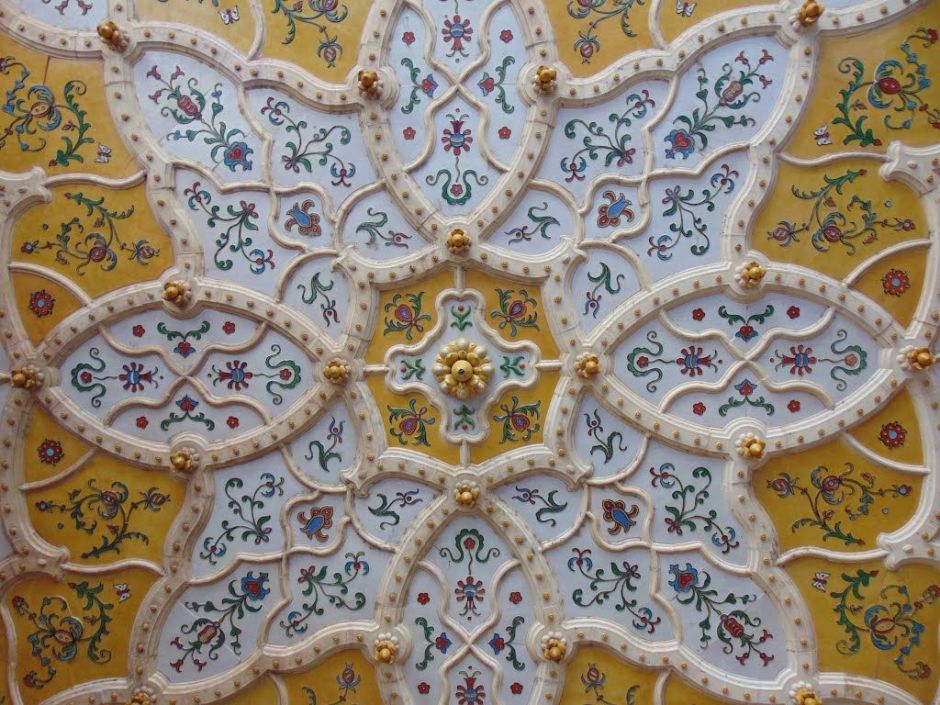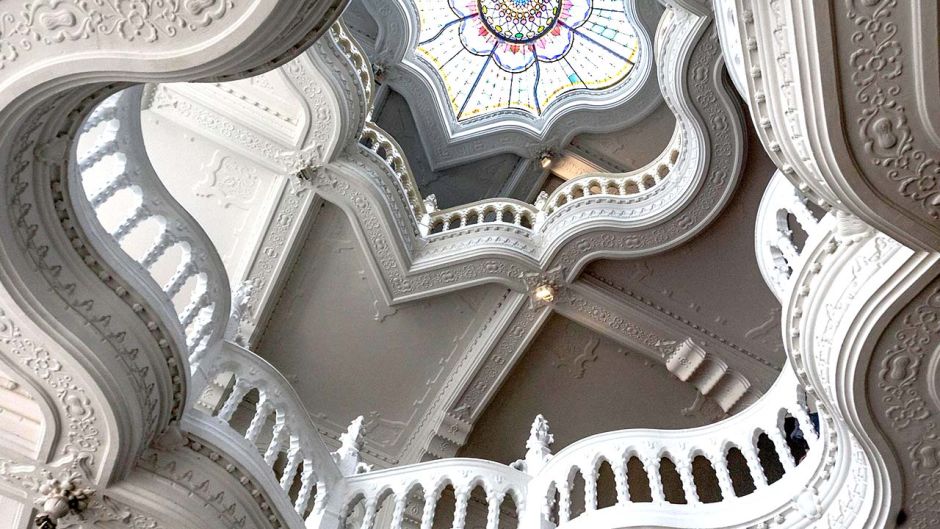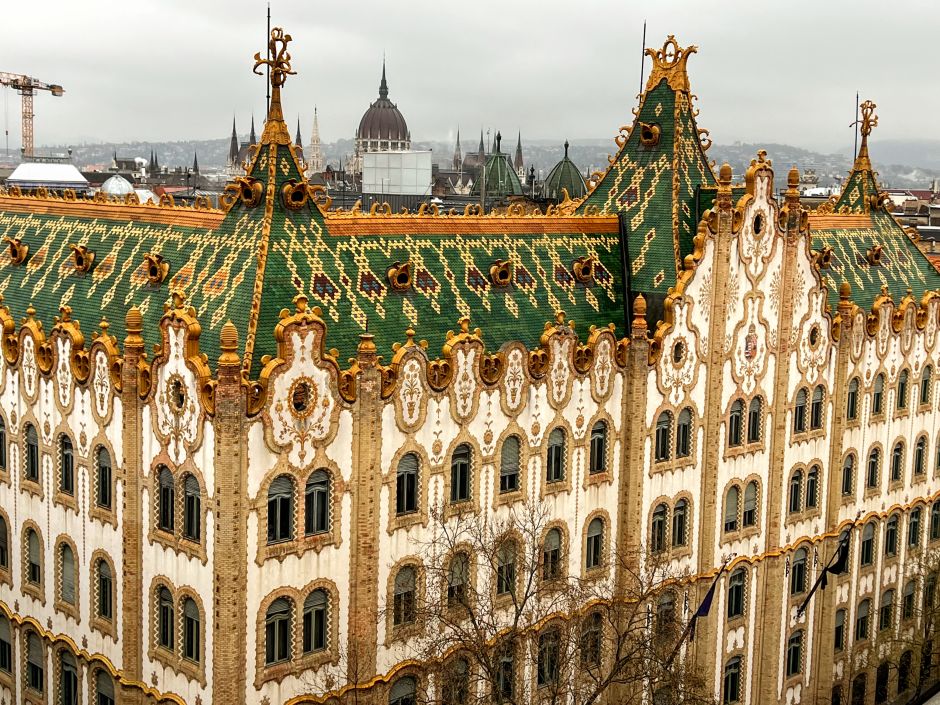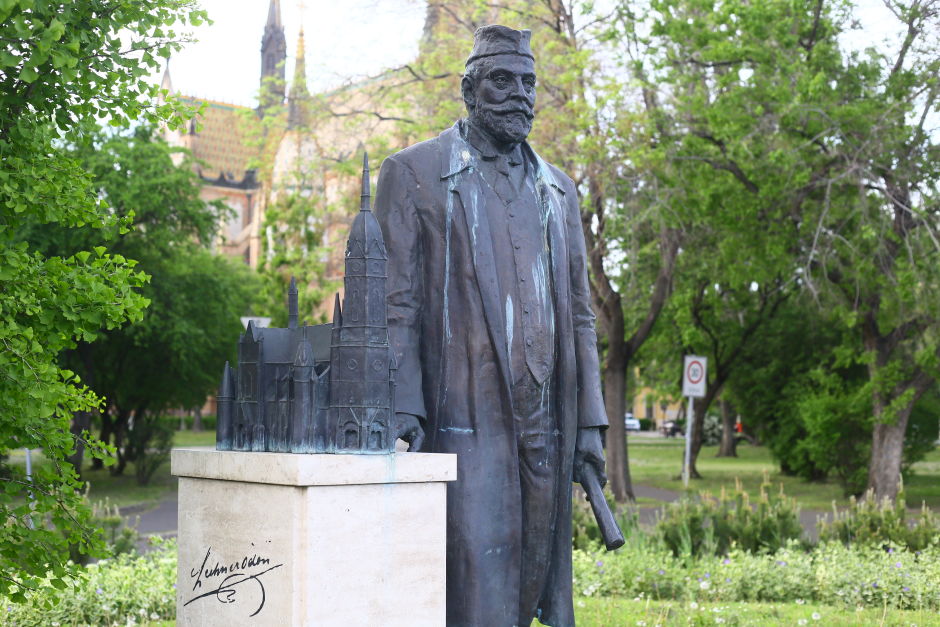Lechner’s lifelong pursuit was to create a distinct Hungarian architecture. After a few brilliant buildings, his career was cut short.

Even if you aren’t especially interested in architecture, there are three buildings in Budapest that will likely make you stop whatever you were doing and take a moment to observe. All three were designed by Ödön Lechner (1845-1914), one of the seminal architects of Hungary. Lechner dismissed the Revival Style that defined 19th-century architecture as being thoughtless imitation, whether neo-Gothic, neo-Renaissance, or neo-Baroque. In fact, he didn’t think much of Hungary’s historical building stock. The Gothic style never reached the heights it did in France or Germany, he argued, and the Ottoman and Habsburg occupations impaired the growth of the Renaissance and the Baroque. But it was time for change.
Lechner came of age after the 1867 creation of Austria-Hungary, a period of rapid economic growth coupled with strong political nationalism. Artists and architects actively explored ways in which a national style might be established.
“How does a national style form? By shaping the great European art movements with the natural instincts of folk art. Our folk art has preserved its native character for centuries; our decorative motifs have always existed among craftsmen, in the works of potters, embroiderers, carpenters, and goldsmiths,” Lechner wrote in 1902.

It took decades for Lechner to find his own voice. Straight out of architecture school in Budapest and Berlin, in the 1860s, he designed the type of Revival buildings he would later frown upon. After a three-year sojourn in Paris spent on castle renovation projects, his works showed the influence of the French Renaissance style to the point that the apartment palace he made for the Hungarian national railway company, MÁV, evokes a Loire Valley chateaux (1882-84). Located right across from the Hungarian State Opera building, it's a jewel of Budapest's Andrássy Avenue (housing a W Hotel currently), but Lechner’s style was to drastically evolve.

The Europe-wide spread of the Art Nouveau movement in the early 1890s finally liberated Lechner from the restraints of historicist architecture. The Art Nouveau meant different things to different people, but the common thread was its desire to break with the past. Hence its manyfold labels: Neue Kunst (new art), Jugendstil (youth style), Secessionist style (the style of the break-away).
In his quest to create a Hungarian national architecture, Lechner found inspiration in Central Asian folk motifs, relying on the (mistaken) findings of ethnographer József Huszka, who claimed that Hungarian tribes culturally overlapped with Persia and India. These theories provided a convenient basis for framing Hungary as a nation distinct from Germanic culture. “I was fascinated by these Eastern relations because they could guide me in my effort to plant folk motifs into monumental architecture.”
These influences are most prominent in the building of the Hungarian Museum of Applied Arts (1891-1896; currently under renovation), with a lively green and gold dome and a richly ornamented entrance portal complete with lush floral patterns. Lechner later admitted that he might have gone too far, calling the entrance “a bit too Indian.” The building was nothing short of revolutionary at the time and most critics praised Lechner's efforts.

Lechner's approach to building materials also deviated from the standard. The practice at the time was to mask decorative details – columns, pediments, cornices, window surrounds – in plaster since stone was too expensive. “Plaster and other fashionable techniques can be excusable on cheaper buildings, but they can’t be the starting point of new artistic forms,” he wrote in a 1911 essay. His solution? Glazed ceramics, which he believed was more compatible with Hungary’s natural resources. “Most of the country consists of a huge flatland, whose residents have barely heard of stone, let alone used it on buildings. On the other hand, ceramics is an ancient craft and decorative elements can be easily made from it.”
Lechner applied ceramic ornaments with such gusto and flourish that his buildings today are best known for these colorful details. He developed a successful collaboration with the Pécs-based Zsolnay, a big Hungarian company that patented and manufactured elaborate shapes of glazed ceramics called pyrogranite (“granite” referred to the material's strength and durability).
In Zsolnay, Lechner found a worthy supplier able to deliver on his precise specifications, be it an idiosyncratic floral pattern or a roof tile with an unexpected shade of green (Lechner’s father owned a brick factory, so Lechner knew enough about ceramics to appreciate the quality and craftsmanship of Zsolnay). Zsolnay’s non-porous decorations were resistant to the cold and polluted city air and aged better than plaster ornaments, which have since disintegrated from wall surfaces and often alarmingly dangle from building facades as a quick walk in Budapest can attest.

Many consider the Postal Savings Bank (1900-1901) in Budapest's city center to be Lechner’s masterpiece. He eliminated most classical elements – the building has no cornice, for example – and designed an enthralling structure that defies easy categorization or comparison. Gently curving brick patterns and Zsolnay’s pyrogranite decorations adorn the undulating facade complete with battlement motifs.
Symbolic elements crowd the striking green roof, some with obvious meanings (bees and honeycombs represent the fruit of hard work), others the offsprings of Lechner’s roving mind (snakes, dragons, and predatory birds). Lechner planted his mystical, archaic Hungarian wonderland into a narrow Budapest side street. “He believed in the expressive power of architectural forms, in their symbolic and magical force,” wrote János Gerle, the editor of a 2003 book called “Ödön Lechner.”
(The most convenient location from which to observe Lechner's Postal Savings Bank is the rooftop bar of the President Hotel across from the building.)

Perhaps paradoxically, Lechner was a staunch modernist when it came to building structures. During his years in Western Europe, he became up-to-date on the latest developments, including the use of steel and reinforced concrete. The Museum of Applied Arts, whose inauguration was attended by the Emperor and King of Austria-Hungary, Franz Joseph, was one of the first in Hungary to feature steel supports and a massive steel-framed glass roof.
The strength of steel enabled Lechner to span longer spaces and create intricate spatial connections that were a hallmark of the Art Nouveau. Nikolaus Pevsner, the prominent 20th-century architectural historian, compared Lechner’s brilliant use of skylights to Le Corbusier’s lighting solutions at the Ronchamp chapel.
For much of his life, Lechner battled serious headwinds from the conservative architectural establishment and the Hungarian state. In theory, his national style aligned with the popular anti-Austrian sentiments of the time, but he was viewed as a reformer and a member of the Art Nouveau, which people associated with Austria (ironically, Lechner didn’t think much of the Austrian Art Nouveau and its most famous practitioner, Otto Wagner). Lechner's main adversaries were Alajos Hauszmann, the esteemed professor of architecture at the Budapest University of Technology, and Ignác Alpár, a prolific and politically connected architect.
Commissions at the turn of the century became increasingly politicized, and architects split into pro- and anti-Lechner camps. Lechner, by nature reserved and far from a shrewd politician, lost major commissions, including the 1899 design for the Budapest Stock Exchange, which went to Alpár. After 1900, few assignments came his way. For a long time, he held out hope that the Ministry of Culture would create a chair for him at the Academy of Fine Arts, as was the case in neighboring Vienna with Otto Wagner, providing him an official platform to disseminate his ideas about national architecture. But it never came to be.

Art Nouveau was short-lived and by the first decade of the 20th century European architecture moved away from Lechner's playful individualism toward calmer and less ornate buildings. This was foreign territory to Lechner and soon he was irretrievably sidelined. In his last built work, an apartment complex in Irányi utca, he tried to fuse the latest fashion of the Austrian Art Nouveau with this "innate" style, but the result is less than convincing.
During the last decades of his life, he became a constant presence at the Japán coffeehouse on Andrássy Avenue, where he shared a table with his famous artist friends and occasionally mentored young architects. He would use the marble tabletops to sketch down his ideas. According to an anecdote, when Marcell Nemes, an art collector, saw Lechner’s drawings for a memorial of Queen Elisabeth, he immediately bought the whole table from the café.
But this was far from the victory lap of a national hero enjoying the sunny years of retirement. Lechner suffered terribly from having been marginalized. In an obituary – Lechner died in 1914 – one of his followers, Béla Jánszky, recalled how Lechner would regularly burst into tears about his broken career. Lechner’s mature period yielded only four public buildings, none from the last decade and a half of his life. Painfully few for a visionary architect whose peak coincided with Budapest's construction boom.

Lechner did have an immense influence on the next generation and his pupils took his vision in different directions. József Vágó migrated toward Otto Wagner’s late-period Viennese Art Nouveau, Béla Lajta and Béla Málnai dropped most ornaments and made a name for themselves as pre-moderns, while Károly Kós shifted to a vernacular based on the traditional buildings of Transylvania. Lechner’s buildings were so personal that those who tried to remain completely loyal to his architecture – such as Marcell Komor and Dezső Jakab – often struggled to carry the torch.

What does this mean for Lechner’s legacy? Was he only a short-lived star on the horizon of Hungarian architecture? Dezső Ekler, one of Hungary’s top architects today, doesn’t think so. “Even more so than his buildings, I consider Lechner’s greatest legacy his innovations and his research. He viewed architecture as a language and he systematically tried to renew it to find Hungary’s voice in it,” he wrote to me.
“As with the greatest architects in history, his buildings doubled as metaphors. Unfortunately, he didn’t get a chance to build more, which is likely the reason he has remained relatively unknown outside of Hungary.”
This link will help you find each of Lechner's major Budapest builings.